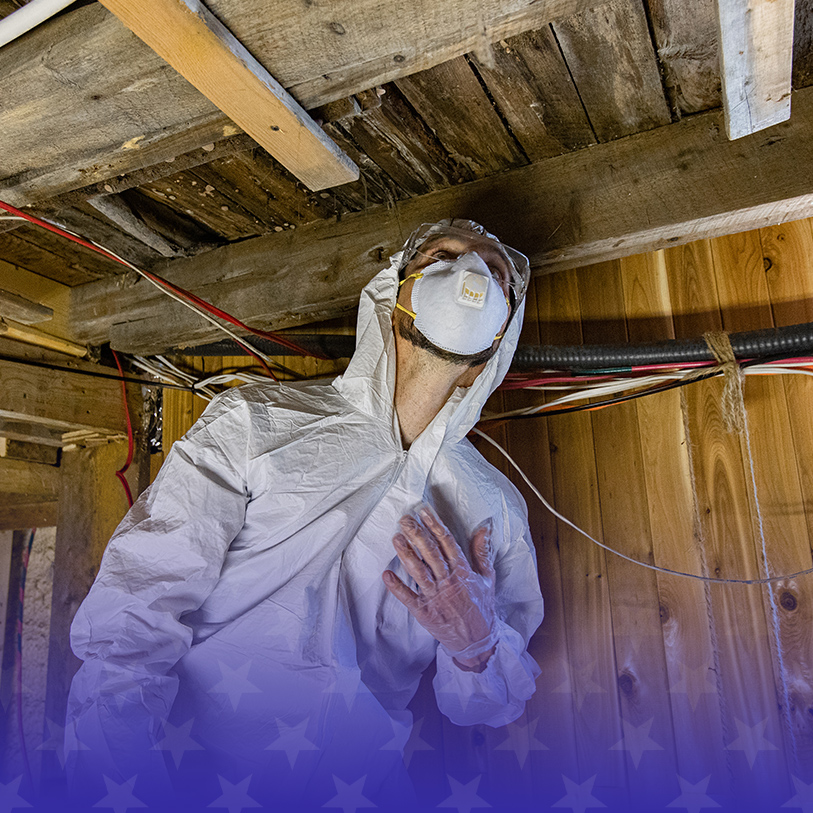
Philadelphia Asbestos Inspections
Keeping Buildings Safe in Montgomery County, Lehigh County, Northampton County, Bucks County, Mercer County, Burlington County, Chester County, & Norristown
Managing hazards associated with asbestos is one of our core services. Eagle has been a regional leader in servicing schools, commercial clients, churches, and homeowners for over 20 years.
Since there are over 3,000 commercial materials and building products that contain asbestos, it’s best to assume that if a building material isn’t wood, metal, or glass, then it could contain asbestos.
Construction materials newer than 1990 are less likely to contain asbestos; however, there are no guarantees. The only way to determine if a building material contains asbestos is to have a sample tested by a qualified AIHA-LAP, LLC-accredited laboratory.
For more information about Philadelphia asbestos inspections, contact us online or call (215) 268-7347.
Our Team has Decades of Experience With Asbestos
Asbestos Removal Services in Your Area - Contact Us Today!
Several federal, state, and city or county regulations must be complied with to successfully manage asbestos projects. Knowing what rules apply and under what circumstances is essential to managing asbestos safely. When asbestos is in good condition and will not be disturbed, often the best practice is to leave it in place and avoid disturbing it.
Employers who are building and facility owners have certain responsibilities under OSHA regulations to identify asbestos and inform housekeeping or maintenance workers where it is located in their buildings.
Key Regulations for Asbestos Disturbance During Renovation
- A “trained individual” must perform a thorough asbestos survey to sample and test all building materials that will be disturbed or removed. An existing asbestos survey may be used to provide background information.
- Certain types of asbestos materials that will be disturbed by the project must be removed by trained or licensed professionals prior to commencing any construction work.
- Other types of asbestos materials may be left in place if they won’t be disturbed or damaged.
- All removed asbestos materials must be handled, transported, and disposed as asbestos waste.
Our trained building inspectors, management planners, and project designers are skilled in evaluating buildings and designing projects to safely remove asbestos. We provide complete project management to oversee contractor operations, as well as quality assurance inspection and air monitoring services.
Our Commitment to Safety and Compliance
- Workers that remove asbestos
- The building environment and its occupants (during or after)
- The outdoor environment (proper procedures and disposal)
Eagle Industrial Hygiene can provide the trained professionals you need to handle your asbestos management needs.
Signs You Need an Asbestos Inspection
Asbestos is a hazardous mineral fiber that was extensively used in construction materials due to its heat resistance, strength, and insulating properties.
However, it is now widely known that exposure to asbestos fibers can cause serious health issues, including:
- Lung cancer
- Mesothelioma
- And asbestosis
Since asbestos was commonly used in buildings until the 1980s, it is important to be aware of the signs that may indicate the presence of asbestos-containing materials (ACMs) in your property.
If you notice any of the following signs, it is crucial to seek an asbestos inspection promptly:
Age of the Building
If your building was constructed before the 1980s, there is a higher likelihood of asbestos-containing materials being present.
This includes:
- Residential homes
- Commercial properties
- Schools
- And public buildings
Older structures often utilized ACMs in various applications, such as insulation, flooring, ceiling tiles, roofing materials, and pipe insulation.
Occupant Complaints or Health Issues
If occupants of a building complain of respiratory problems, unexplained allergies, persistent coughing, or other respiratory symptoms that cannot be attributed to other causes, it is crucial to consider the possibility of asbestos exposure.
Asbestos fibers can become airborne and circulate within a building, posing a health risk to occupants. In such cases, an asbestos inspection can help identify potential sources and guide appropriate remediation measures.
It is important to remember that visual inspection alone is insufficient to determine the presence of asbestos. Only certified asbestos inspectors can accurately assess the presence, condition, and risk associated with ACMs.
At Eagle Industrial Hygiene, we conduct a thorough inspection, sample collection, and provide expert guidance on managing asbestos hazards safely. Your health and the well-being of those in your building are paramount, and proactive asbestos inspections are a crucial step in maintaining a safe environment.
How to Handle Asbestos
There are many rules that determine how to handle asbestos:
- When in doubt, assume building materials contain asbestos (exceptions are wood, metal, and glass)
- Have materials tested by a qualified AIHA-LAP,LLC-accredited laboratory
- If you don't have to disturb it, leave it alone
- Renovation or demolition projects require specific procedures and testing
- Only trained personnel are permitted to test, remove, or handle asbestos
For more information, contact us online or call (215) 268-7347.


Why Choose Eagle Industrial Hygiene Associates?
-
Wide Range of Experience From Inspections to Large Environmental Disasters
-
Serving the Community Since 1986 With Thousands of Customers Helped
-
Staff with Certified Industrial Hygienist Credentials
-
Qualified Member of ISNetworld Global Contractor and Supplier Management